Omega Centauri (ω Centauri) is a bright globular cluster located approximately 17,090 light-years away in the southern constellation Centaurus. With an apparent magnitude of 3.9, the cluster is easily visible to the unaided eye on a clear night. It is the largest and most massive globular cluster in the Milky Way galaxy. The star cluster is listed as NGC 5139 in the New General Catalogue and as Caldwell 80 (C80) in the Caldwell catalogue.
Omega Centauri is the brightest globular cluster in the sky. With an apparent size of 36.3 arcminutes, it would appear larger than the full Moon if it were not fainter than the Earth’s satellite. 47 Tucanae, the second brightest globular, shines at magnitude 4.09, but has a larger apparent size of 43.8 arcminutes.
Omega Centauri contains around 10 million stars within a diameter of 150 light-years. The central region of the cluster is so tightly packed that the stars are estimated to be only 0.1 light years away from each other. In comparison, the distance from the Sun to its nearest neighbour, Proxima Centauri, is 4.2465 light-years.
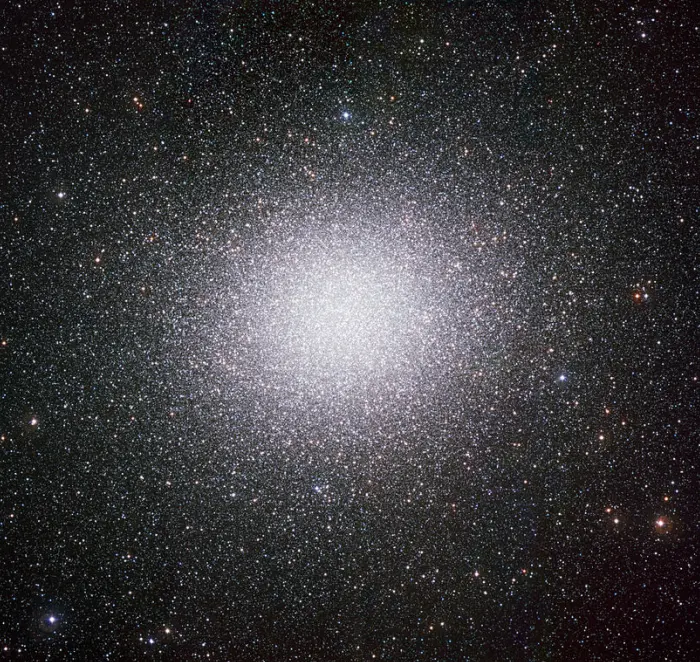
The globular cluster Omega Centauri — with as many as ten million stars — is seen in all its splendour in this image captured with the WFI camera from ESO’s La Silla Observatory. The image shows only the central part of the cluster — about the size of the full moon on the sky (half a degree). North is up, East is to the left. This colour image is a composite of B, V and I filtered images. Image credit: ESO (CC BY 4.0)
Omega Centauri is different from the other 200 or so globular clusters in the Milky Way. It is ten times more massive than a typical large globular cluster in our galaxy and almost as massive as a small galaxy. It rotates much faster than other clusters and has a flattened shape. The cluster’s fastest members move at 21 km/s.
Globular clusters orbit our galaxy outside the galactic disk. They contain tens of thousands to millions of member stars that are bound together by gravity and remain intact for billions of years.
Stars in other globular clusters typically have a similar age and chemical composition. Members of the Omega Centauri cluster show different chemistry and a wide age range, from 12 billion years to relatively young.
The distinctiveness of Omega Centauri has led scientists to theorize that it may have a different origin. They believe that the cluster is the core remnant of a dwarf galaxy that was disrupted and destroyed in an encounter with the much larger Milky Way.
Omega Centauri is one of the most massive clusters in the Local Group of galaxies. It has a mass of about 5 million Suns. The only known globular cluster that is more massive is Mayall II (Andromeda’s Cluster), which lies in the neighbouring Andromeda Galaxy (Messier 31). Like ω Cen, Mayall II has a diverse stellar population and is believed to be the galactic core of a dwarf galaxy that merged with the larger Andromeda.
Omega Centauri has an estimated age of 12 billion years. It is home to several million Population II stars. These are old, metal-poor stars that formed when the universe was much younger and less enriched with the heavier elements. They are commonly found in the galactic halo. The stars in NGC 5139 are believed to have formed over a period of 2 billion years, with several peaks in starburst activity.
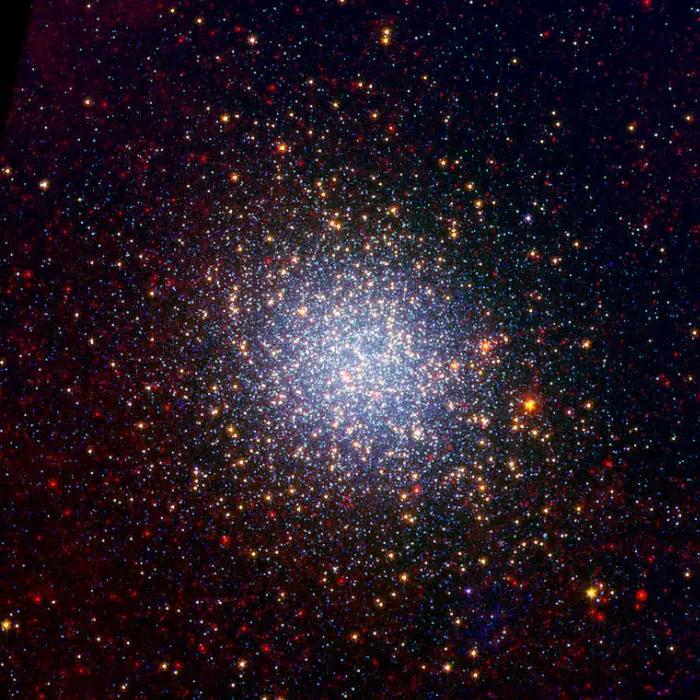
A cluster brimming with millions of stars glistens like an iridescent opal in this image from NASA’s Spitzer Space Telescope. Called Omega Centauri, the sparkling orb of stars is like a miniature galaxy. It is the biggest and brightest of the 150 or so similar objects, called globular clusters, that orbit around the outside of our Milky Way galaxy. Stargazers at southern latitudes can spot the stellar gem with the unaided eye in the constellation Centaurus. Image credit: NASA, JPL-Caltech, Jacco Th. van Loon (Keele University), Martha L. Boyer (University of Minnesota), Iain McDonald (Keele University), Charles Woodward (University of Minnesota), Robert Gehrz (University of Minnesota), Nye Evans (Keele University), Andrea Dupree (Harvard Smithsonian Center for Astrophysics) (PD)
It is the presence of different stellar populations that has led to speculation that Omega Centauri is not really a globular cluster, but a dwarf galaxy stripped of its outer stars. The cluster is believed to be what is left of the nucleus of a disrupted dwarf galaxy, one torn to shreds by the gravity of the Milky Way.
In 2008, a study by Eva Noyola (Max Planck Institute for Astrophysics in Germany & University of Texas, USA), Karl Gebhardt (University of Texas) and Marcel Bergmann (Gemini Observatory) showed evidence of an intermediate-mass black hole at the core of ω Cen. The discovery was based on observations made by the Gemini Observatory in Chile and the Hubble Space Telescope.
The Hubble images obtained with the Advanced Camera for Surveys (ACS) revealed that there was a greater concentration of stars near the centre of the cluster. The instruments at the Gemini Observatory showed that stars closer to the centre were moving at greater speeds than stars that were farther away from the cluster’s core.
This led the researchers to conclude that there was unseen matter at the centre of the cluster that was interacting gravitationally with the nearby stars, most likely a dense, massive object like a black hole. They calculated the mass of the black hole at 40,000 solar masses. The findings were announced in a paper titled “Gemini and Hubble Space Telescope Evidence for an Intermediate Mass Black Hole in Omega Centauri,” published in The Astrophysical Journal in April 2008.
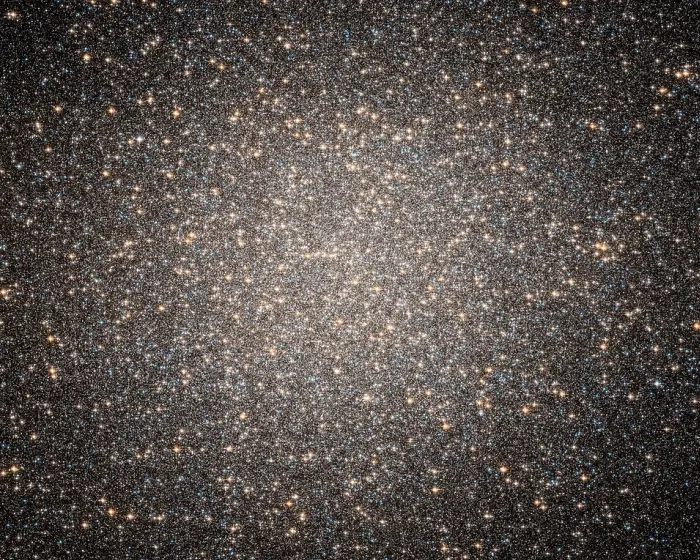
The Hubble image was created using HST data from proposal 9442: A. Cool (San Francisco State University), J. Anderson (STScI), D. Bailyn (Yale University), J. Carlin (San Francisco State University), P. Edmonds (Harvard-Smithsonian Center for Astrophysics), J. Grindlay (Harvard University), and D. Haggard (University of Washington). Image credit: NASA, ESA and the Hubble Heritage Team (STScI/AURA); Acknowledgment: A. Cool (San Francisco State University) and J. Anderson (STScI) (CC BY 2.0)
A 2009 study by Jay Anderson and Roeland P. van der Marel at the Space Telescope Science Institute (STScI) did not confirm these findings. The researchers found that the proper-motion dispersion of Omega Centauri gradually increases inwards, but with little variation in kinematics within the central 15 arcseconds of the cluster and no high-velocity stars near the centre.
They determined the cluster’s centre to be 12 arcseconds from the centre observed by Hubble and Gemini in the 2008 study. The scientists also pinpointed the kinematical centre using data from the 2MASS catalogue. This was the first time that the kinematical centre of a globular star cluster was accurately determined.
In 2009, Anderson and van der Marel firmly ruled out the mass of the black hole proposed in the 2008 study. They constrained the mass of a potential intermediate-mass black to hole to 12,000 solar masses.
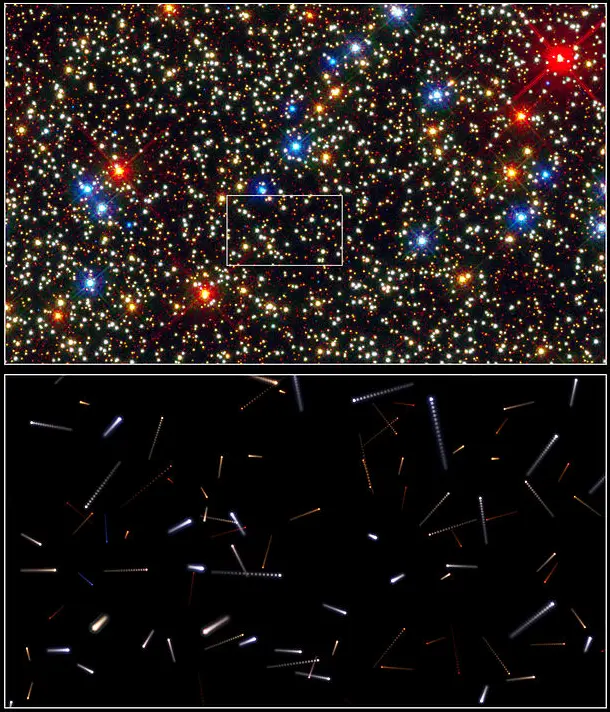
The multi-colour snapshot (top), taken with the Wide Field Camera 3 aboard the NASA/ESA Hubble Space Telescope, captures the central region of the giant globular cluster Omega Centauri. All the stars in the image are moving in random directions, like a swarm of bees. Astronomers used Hubble’s exquisite resolving power to measure positions for stars in 2002 and 2006. From these measurements, they can predict the stars’ future movement. The lower illustration charts the future positions of the stars highlighted by the white box in the top image. Each streak represents the motion of the stars over the next 600 years. The motion between the dots corresponds to 30 years. Image credit: NASA, ESA, J. Anderson and R. van der Marel (STScI) (CC BY 3.0)
In 2018, astrophysicist Stephen R. Kane at the University of California – Riverside and Sarah J. Deveny, a graduate student at San Francisco State University, used observations of Omega Centauri’s core with the Hubble Space Telescope to study the stars in the cluster’s central region. They found that the average distance between the stars was only 0.16 light-years.
Kane and Deveny concluded that the small distance would lead to disruptive gravitational interactions between the stars every 1.65 million years that would most likely prevent the formation of planetary systems in stable orbits. Even though the cluster may have a large population of red dwarfs similar to TRAPPIST-1 and likely terrestrial planets, the tidal interactions between the stars disrupt and scatter the planets, significantly reducing the chance of habitability and life developing on the planets.
In 2019, a team of astronomers led by Rodrigo A. Ibata from the University of Strasbourg identified a long stellar stream extending up to 18 degrees from Omega Centauri. This was the first discovery of the actual tidal arms of the globular cluster.
The tidal stream is believed to be the remnant of an ancient accretion event. Composed of stars that were torn off from Omega Cen when it collided with the Milky Way, the feature was nicknamed the “Fimbulthul” stream, after a river in Norse mythology that existed at the beginning of the world. The stream stretches over 18 degrees in the constellations Centaurus and Hydra.
+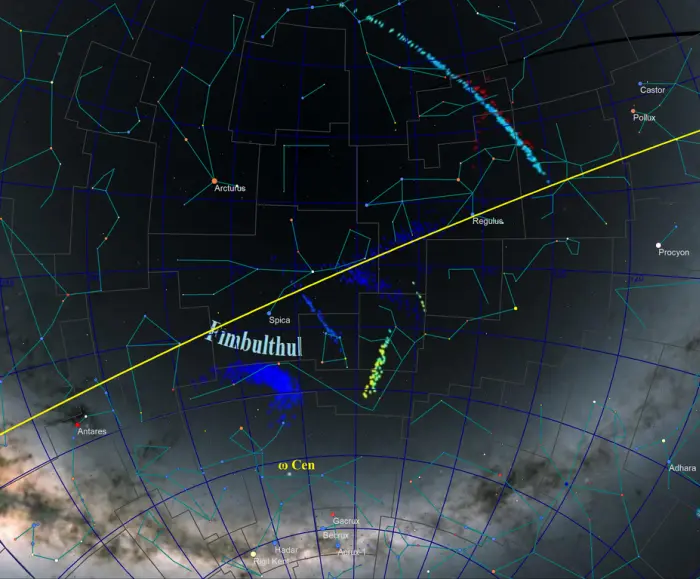
Fimbulthul (star stream) projection onto celestial sphere, image credit: Wikimedia Commons/Tomruen (+)The researchers analysed the data obtained by the ESA Gaia mission (Gaia Data Release 2) and found 309 stars with an estimated age of 12.5 billion years. Additionally, they studied spectroscopic data obtained by the Canada-France-Hawaii Telescope (CFHT) to study six candidate members of the stream and found that five had similar radial velocities.
The findings were published in Nature Astronomy on April 22, 2019.
In November 2019, a team of astronomer identified three other stars outside of the tidal radius believed to be associated with Omega Centauri, based on the GALAH survey. GALAH (GALactic Archaeology with HERMES) is an observing program that uses the HERMES instrument on the Anglo-Australian Telescope at the Siding Spring Observatory, Australia, to obtain simultaneous spectra of 400 stars at a time and trace the history of the Milky Way.
In the 2020s, astronomers discovered 18 millisecond pulsars in Omega Centauri using the Parkes and MeerKAT radio telescopes. Subsequent studies with the Chandra X-ray Observatory identified 11 pulsars that were emitting X-rays, five of which were so-called spider pulsars close to the cluster’s core. The spider pulsars destroy any small companion stars within their reach. The X-rays and streams of energetic particles they emit strip away the outer layers of any smaller companions.
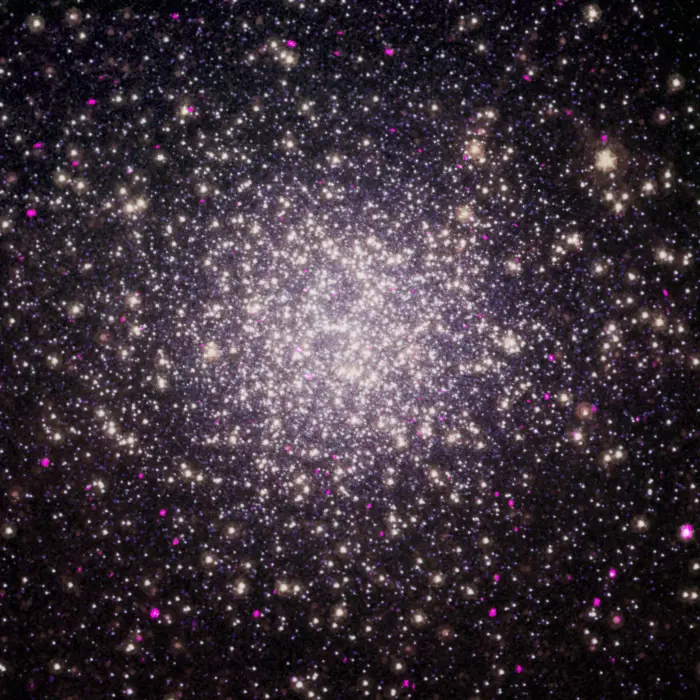
A group of dead stars known as “spider pulsars” are obliterating companion stars within their reach. Data from NASA’s Chandra X-ray Observatory of the globular cluster Omega Centauri is helping astronomers understand how these spider pulsars prey on their stellar companions. Image credit: X-ray: NASA/CXC/San Francisco State Univ./A. Cool et al.; Optical: NASA/ESA/STScI/AURA; Image Processing: NASA/CXC/SAO/N. Wolk (PD)
In 2024, a team led by Imants Platais of the Department of Physics and Astronomy, Johns Hopkins University, and Johannes Sahlmann of the European Space Agency’s Gaia mission reported the discovery of astrometric accelerations of stars at the core of Omega Centauri. After analysing around 160,000 sources, the astronomers found four stars with an acceleration pattern that suggested the gravitational pull of an invisible companion. They found periods of 8.8 to over 19 years and dark companions with masses of 0.7 to 1.4 solar masses. At least one of the invisible companions is a neutron star candidate.
The discovery was based on observations with the Hubble Space Telescope’s Wide Field Camera 3 (WFC3) and the Ultraviolet-Visible (UVIS) imager. The findings were published in The Astrophysical Journal, Volume 963.
A 2024 study led by Maximilian Häberle of the Max Planck Institute for Astronomy in Heidelberg, Germany, reported the detection of seven fast-moving stars within 3 arcseconds of the cluster’s centre. The high velocities of the stars may indicate the presence of a massive black hole. The researchers derived a firm lower limit on the mass of around 8,200 solar masses for the candidate intermediate-mass black hole.
Facts
Omega Centauri was catalogued as a single star by the Greek astronomer Ptolemy in his Almagest in the 2nd century CE. Ptolemy described the object as a star on the horse’s back, “Quae est in principio scapulae.”
The German cartographer Johann Bayer used Ptolemy’s data when he included the object in his star atlas Uranometria, published in 1603. Bayer was the one who designated the cluster Omega Centauri. Bayer assigned Greek letter designations to stars based on the order of magnitude. Since the cluster appeared as a dim star (the first telescope was invented a few years later), it was given the Bayer designation Omega.
English astronomer and physicist Edmond Halley was the first to list Omega Centauri as a non-stellar object in 1677. Halley observed the cluster from the island of Saint Helena in the South Atlantic. He included it on his list of six “luminous spots or patches” in his Catalogue of Southern Stars, published in the Philosophical Transactions of the Royal Society in 1716.
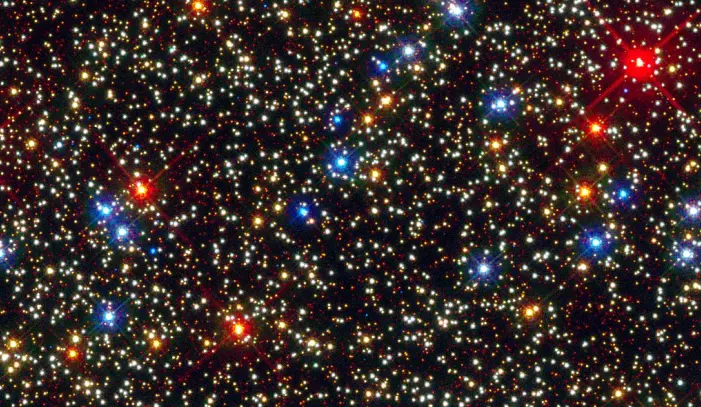
NASA’s Hubble Space Telescope snapped this panoramic view of a colorful assortment of 100,000 stars residing in the crowded core of a giant star cluster. The image reveals a small region inside the massive globular cluster Omega Centauri, which boasts nearly 10 million stars. Globular clusters, ancient swarms of stars united by gravity, are the homesteaders of our Milky Way galaxy. The stars in Omega Centauri are between 10 billion and 12 billion years old. The cluster lies about 16,000 light-years from Earth. Image credit: NASA, ESA, and the Hubble SM4 ERO Team (CC BY 2.0)
In 1746, Swiss astronomer Jean-Philippe de Cheseaux included Omega Cen on his list of 21 nebulae, and the French astronomer Nicolas Louis de Lacaille included it in his catalogue in 1755 under the number L I.5.
Scottish astronomer James Dunlop was the first to identify Omega Centauri as a globular cluster in 1826. Dunlop observed the cluster from Australia and described it as a “beautiful globe of stars very gradually and moderately compressed to the centre.”
English astronomer John Herschel observed Omega Centauri with a large telescope in the 1830s and also recognized it as a globular cluster.
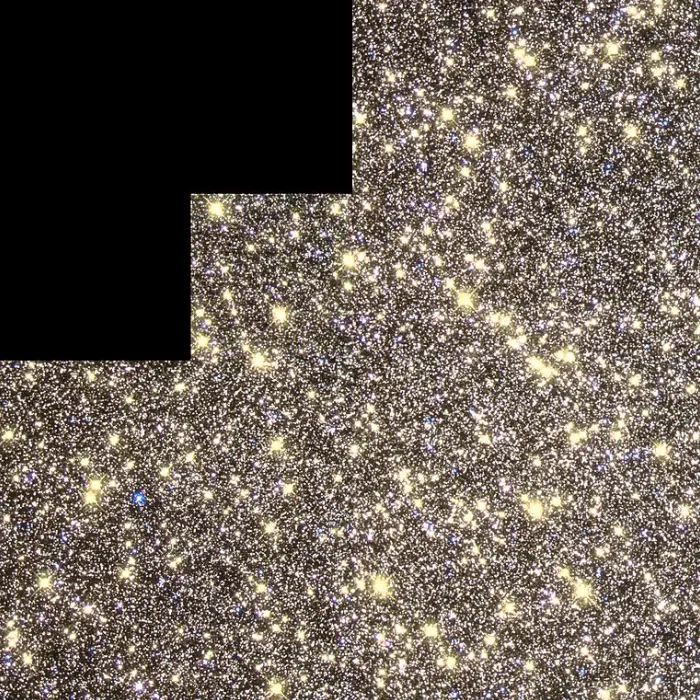
This Hubble image, which includes ultraviolet and visible light captured by the Wide Field and Planetary Camera 2 in 1997, zooms in on the center of Caldwell 80 (Omega Centauri). The vast majority of stars in the image are faint, yellow-white dwarf stars similar to our Sun. The handful of bright yellow-orange stars are red giants that have begun to exhaust their nuclear fuel and have expanded to diameters about a hundred times that of the Sun. A number of faint blue stars are also visible in the image. These are in a brief phase of evolution between the dwarf stage and the red-giant stage, during which the surface temperature is high. The image resolves about 50,000 stars in a region about 13 light-years across. Credit: NASA/ESA and the Hubble Heritage Team (STScI/AURA); Acknowledgment: A. Cool (SFSU) (CC BY 2.0)
Kapteyn’s Star, a red subdwarf located only 12.83 light-years away, is believed to have once been a member of Omega Centauri. It belongs to a moving group of stars that have similar element abundances to the stars in the cluster. The stars also share a common motion through space. Kapteyn’s Star and other members of the moving group are thought to have been stripped away from ω Cen as tidal debris when the dwarf galaxy merged with the larger Milky Way.
Kapteyn’s Star has a mass of only 0.281 solar masses and a radius of 0.291 solar radii. It has an estimated age of 11.5 billion years. It lies in the constellation Pictor and is the nearest halo star to the Sun. It shines at magnitude 8.853, below unaided eye visibility, but can be seen in binoculars and small telescopes.
Omega Centauri is notably mentioned in Ian Douglas’ novel Singularity (2012), which presents as fact that Omega Centauri and Kapteyn’s Star originate from a dwarf galaxy. The origin of the star and the cluster is part of the novel’s main plot.
Location
Omega Centauri can be found using the bright stars of the constellations Centaurus and Crux. The star cluster lies roughly halfway between Menkent (Theta Centauri) at the Centaur’s shoulder and Gacrux (Gamma Crucis), the red star at the top of the Southern Cross. A line extended from Imai (Delta Crucis) through Gacrux points in the direction of Omega Centauri and Menkent.
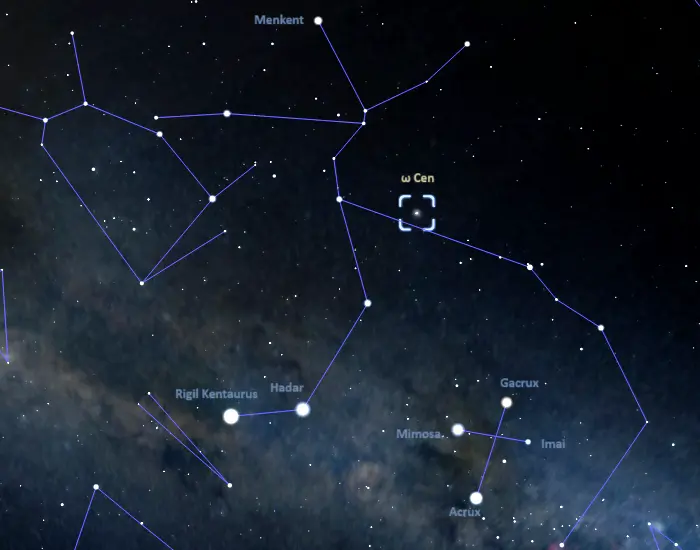
The location of Omega Centauri (NGC 5139), image: Stellarium
In the northern hemisphere, Omega Centauri can be located using Spica, the brightest star in the constellation Virgo and one of the brightest stars in the sky. Omega Centauri and Spica transit together, i.e. they reach the highest point in the sky and appear due south at the same time, only the cluster transits some 35 degrees south of Spica. 10 degrees is roughly equal to the size of a fist held at an arm’s length. Spica can be found by following the arc of the Big Dipper‘s handle. The imaginary line leads first to Arcturus and then to Spica.
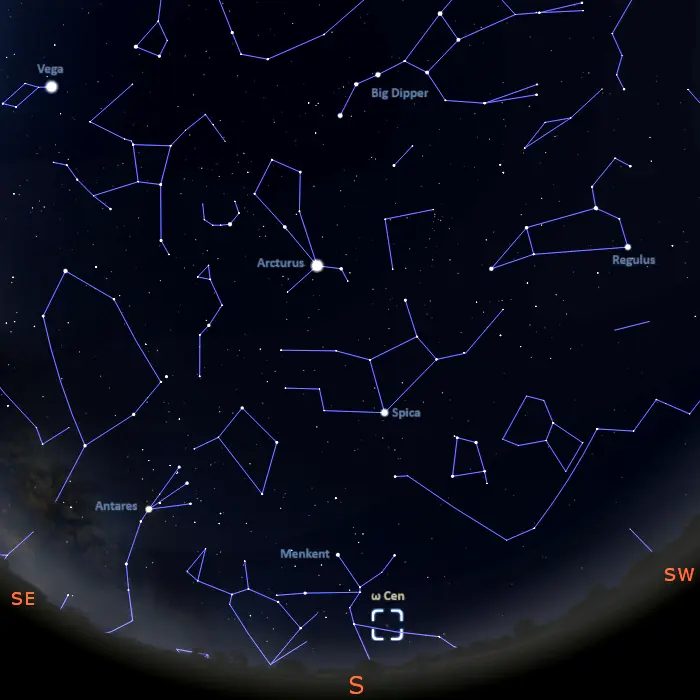
Omega Centauri and Spica, image: Stellarium
Omega Centauri is visible to the unaided eye, but best seen through a telescope. When observed from a dark area, it appears almost the size of the full Moon. The cluster can only be seen at certain times of the year from the northern hemisphere. The best time to observe it is in the evenings in late April, May, and early June.
The cluster appears as a comet without a tail or a fuzzy star to the unaided eye. Binoculars will reveal a hazy disk. A 6-inch telescope will show many of the cluster members, and 10-inch instruments will reveal the cluster’s dense core and thousands of stars extending away from it.
At declination -47˘ 28’, Omega Centauri is visible from locations south of the latitude 42° N. Due to its location in the far southern sky, it stays very close to the southern horizon for observers in the mid-northern latitudes. The cluster is best seen from the southern hemisphere.
Omega Centauri – NGC 5139
| Constellation | Centaurus |
| Object type | Globular cluster |
| Class | VIII |
| Right ascension | 13h 26m 47.28s |
| Declination | -47° 28’ 46.1” |
| Apparent magnitude | 3.9 |
| Apparent size | 36′.3 x 36’.3 |
| Distance | 15,800 ± 1,100 light-years (4,840 ± 340 parsecs) |
| Radius | 86 light years |
| Age | 11.52 billion years |
| Names and designations | Omega Centauri, ω Centauri, NGC 5139, Caldwell 80, GCI 24, FL8Y J1326.7-4729, CD-46 8646, CPD-46 6348, MWSC 2120, HD 116790, 1E 1323.8-4713, 2FGL J1326.4-4729, 3FGL J1326.7-4727, 4FGL J1326.6-4729, C 1323-472 |
Images
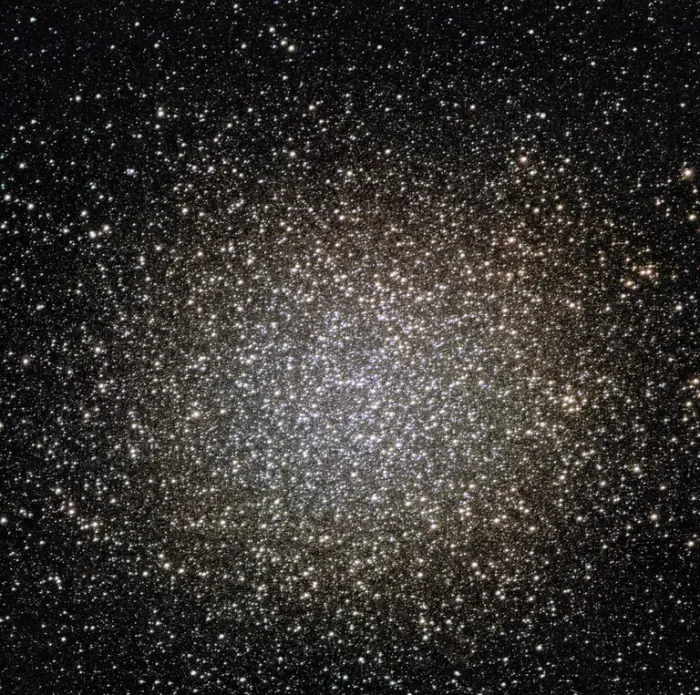
During its commissioning and capabilities testing, astronomers used NEWFIRM on the Víctor M. Blanco 4-meter Telescope at Cerro Tololo Inter-American Observatory (CTIO) in Chile to capture a spectacular image of the Omega Centauri globular cluster. Image credit: CTIO/NOIRLab/DOE/NSF/AURA, T.A. Rector (University of Alaska Anchorage/NSF’s NOIRLab), M. Zamani & D. de Martin (NSF’s NOIRLab) (CC BY 4.0)
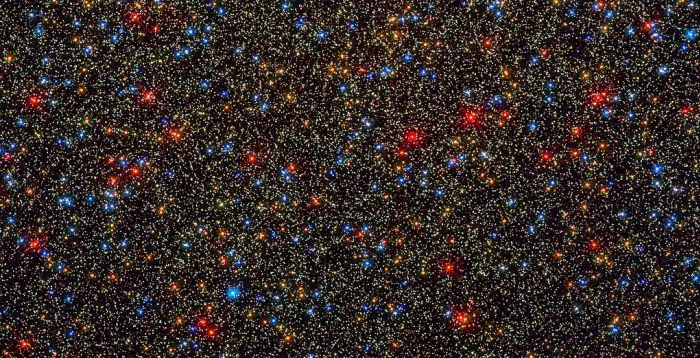
Hubble’s Wide Field Camera 3 captured this image in ultraviolet and visible light showing 100,000 stars in the core of Caldwell 80 (Omega Centauri) soon after the camera was installed in 2009. The stars’ colors give us information about them. Bright blue stars are old, hot stars that are fusing helium in their cores. Bright red stars are cool giants that are heading into old age. Dimmer red stars are cool dwarfs destined to live for a long time. White stars are typically middle-aged, average stars. Credit: NASA, ESA and the Hubble SM4 ERO Team (CC BY 2.0)
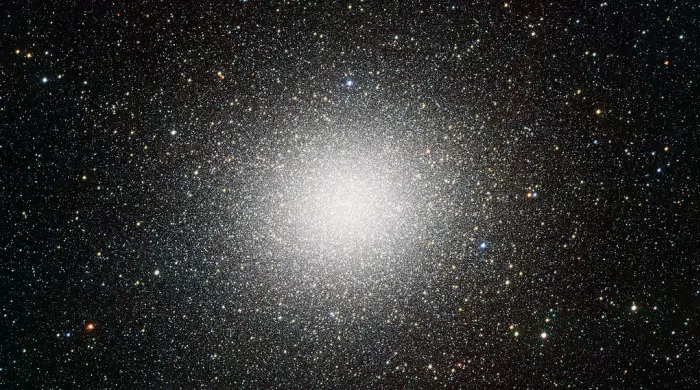
The second released VST image may be the best portrait of the globular star cluster Omega Centauri ever made. Omega Centauri, in the constellation of Centaurus (The Centaur), is the largest globular cluster in the sky, but the very wide field of view of VST and its powerful camera OmegaCAM can encompass even the faint outer regions of this spectacular object. This view includes about 300 000 stars. The data were processed using the VST-Tube system developed by A. Grado and collaborators at the INAF-Capodimonte Observatory. Image credit: ESO/INAF-VST/OmegaCAM. Acknowledgement: A. Grado/INAF-Capodimonte Observatory (CC BY 4.0)
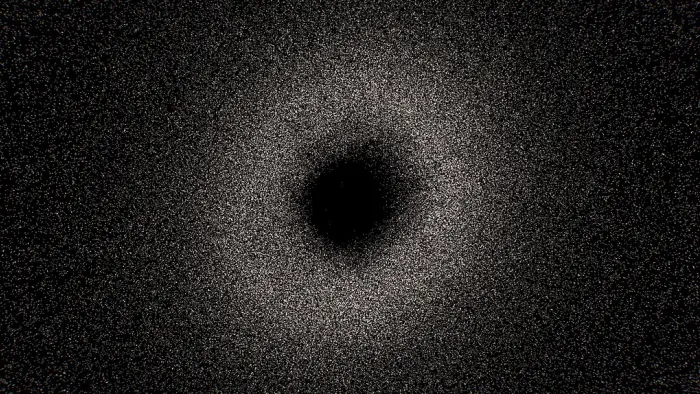
ESA’s star-surveying Gaia mission has released a treasure trove of new data as part of its ‘focused product release’. As part of this data release Gaia explored Omega Centauri, the largest globular cluster that can be seen from Earth and a great example of a ‘typical’ cluster. Image credit: ESA/Gaia/DPAC (CC BY-SA 3.0)